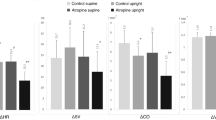Summary
Ten dogs were subjected to bilateral removal of thoracic sympathetic chains so as sympathetically to denervate the heart while leaving vagal control intact (so-called Vagal Dogs). Their cardiac output was then estimated at different levels of exercise. The estimation was repeated on eight of these same animals about a year later with almost identical results. Comparing these results with cardiac exercise outputs of seven normal dogs, it emerges that possession of the vagus alone allows normal cardiac response during exercise. Surprisingly, cutting both vagi in these vagal dogs resulted in practically no immediate deterioration of their cardiac response to exercise. These recently vagotomized animals were then contrasted with a group of eight dogs whose hearts had been completely denervated some months previously. The latter had relatively poor cardiac adaptation to exercise.
It was concluded that in the sympathectomized dogs even the recent possession of the vagus confers almost full power of cardiac adaptation to exercise. It is suggested that the recent possession of the vagus has trophic influence on the heart enabling it to retain mitochondria essential to normal function.
Similar content being viewed by others
References
Ashkar, E.: Effect of cardiac output response to exercise in dogs after splanchnic denervation. Atl. Physiol. Lat. Amer.16, 387–388 (1966).
Ashkar, E.: Heart rate and blood pressure during exercise in dogs with autonomic denervation. Amer. J. Physiol.210, 950–952 (1966).
— Hamilton, W. F.: Cardio-vascular response to graded exercise in the sympathectomized dog. Amer. J. Physiol.204, 291–296 (1963).
Barta, E., Bozner, A., Cerny, J., Mrena, E.: Influence of surgical denervation of the heart on the structural integrity of the heart muscle. Exp. Med. Surg.24, 228–238 (1966).
—, Breuer, E., Pappoun, E., Zlatos, L.: Influence of surgical denervation of the heart on the energetic metabolism and cardiac efficiency. Exp. Med. Surg.24, 319–333 (1966).
Benitez, D., Holmoren, B., Middleton, S.: Sympathetic cardiac stimulating fibres in the vagi. Amer. J. Physiol.197, 739–742 (1959).
Broha, L., Cannon, W. B., Dill, D. B.: The heart rate of the sympathectomised dog in rest and exercise. J. Physiol. (Lond.)87, 345–359 (1936).
Calaresu, F. R., Pearce, J. W.: Effects on heart rate of electrical stimulation of medullary vagal structures in the cat. J. Physiol. (Lond.)176, 241–251 (1965).
Chiang, T. S., Leaders, F. E.: Cardiostimulatory responses to vagal stimulation nicotine and tyramine. Amer. J. Physiol.211, 1443–1446 (1966).
Cooper, T.: Physiologic and pharmacologic effects of cardiac denervation. Fed. Proc.24, 1428–1431 (1965).
—, Hirsch, E. F., Willman, U. L., Hancon, C. R.: Transplantation of the heart. Alterations in morphology. Arch. Surg.89, 915–920 (1964).
Copen, D. L., Cirillo, D. P., Vassalle, M.: Tachycardia following vagal stimulation. Amer. J. Physiol.215, 696–703 (1968).
Glick, G., Braunwald, E.: Relative roles of the sympathetic and parasympathetic nervous systems in the reflex control of heart rate. Arch. Res.16, 363–375 (1965).
Goldstone, B. W., Wyndham, C. H.: Cardiac adaptation to exercise. Pflügers Arch. ges. Physiol.295, 15–29 (1967).
Hodes, R.: Exercise in the sympathectomized cat. Amer. J. Physiol.126, 171–179 (1939).
Hullin, R. P., Noble, R. C.: The determination of lactic acid in micro-quantities. Biochem. J.55, 289–297 (1953).
Jeffersen, N. C., Geisel, B. S., Cott, P., Necheles, H.: Vagus denervation in the dog. Surgery61, 808–811 (1967).
Jellinek, M., Kaye, M. P., Kaiser, G. L., Cooper, T.: Effect of cervical vagosympathectomy on myocardial cathecholamine concentration. Amer. J. Physiol.209, 951–954 (1966).
Jourdan, F., Nowak, S. J. G.: Les fibres cardio-acceleratrices dans le nerf pneumogastrique du chien; leur origine and leur trajet. C. R. Soc. Biol. (Paris)117, 234–238 (1934).
Kabat, H.: The cardio-accelerator fibres in the vagus nerve of the dog. Amer. J. Physiol.128, 246–257 (1939/40).
Kisch, B.: A significant electron microscope difference between the atria and the ventricles of the mammalian heart. Exp. Med. Surg.21, 193–221 (1963).
—: The perinuclear space in cardiac muscle (A spot of high enzymatic activity). Exp. Med. Surg.21, 222–230 (1963).
—: Further studies about the micro bodies in the atria of the heart. Exp. Med. Surg.23, 1–12 (1965).
—: The perinuclear space in the atrium of cold-blooded vertebrates. Exp. Med. Surg.23, 243–247 (1965).
Kisch, B.: Testing the sarcosome protecting powers of certain drugs. Exp. Med. Surg.23, 406–412 (1965).
Kisch, B.: Enzymology of the myocardium. Exp. Med. Surg. Suppl.1965, 140–149.
Knox, J. A. C., McDowall, R. J. S.: Functions of the vagus and acetylcholine in the control of the circulation of the blood. Arranged by R. J. S. McDowall. London: Wm. Dawson and Sons Ltd. 1956.
Middleton, S., Middleton, H. H., Tona, J.: Adrenergic mechanism of vagal-stimulation. Amer. J. Physiol.158, 31–37 (1949).
Van Slyke, D. D., Neill, J. M.: The determination of gases in blood and other solutions by vacuum extraction and manometric measurements. J. biol. Chem.61, 523–573 (1934).
Willman, U. L., Cooper, T., Kairser, G. C., Hancon, L. R.: Cardiovascular response after cardiac autotransplant in primate. Arch. Surg.91, 805–806 (1965).
Author information
Authors and Affiliations
Rights and permissions
About this article
Cite this article
Goldstone, B.W., Silberstein, M.J. & Wyndham, C.H. The role of the vagus nerve in cardiac adaptation to exercise. Pflugers Arch. 325, 113–124 (1971). https://doi.org/10.1007/BF00587002
Received:
Issue Date:
DOI: https://doi.org/10.1007/BF00587002



